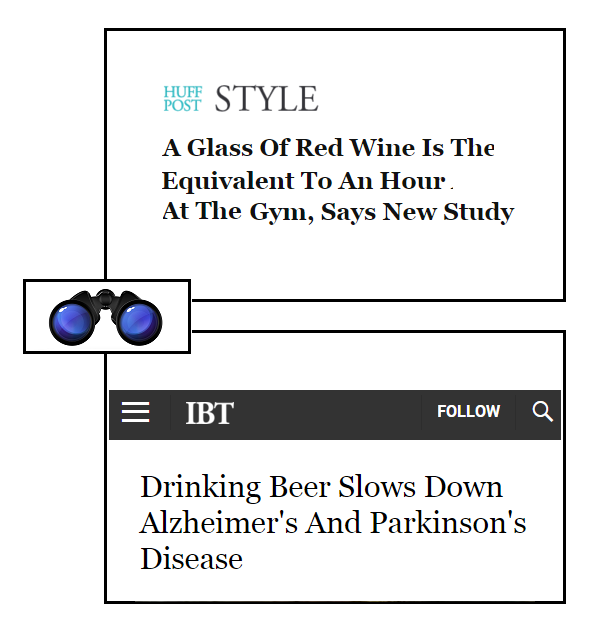Sunday surprise: what’s your health tipple?
[ by Charles Cameron — cheers! ]
.
Here’s our topic statement:
**
Okay. I thought you might like to know:
Exercise training (ET) improves endurance capacity by increasing both skeletal muscle mitochondrial number and function, as well as contributing to favourable cardiac remodelling. Interestingly, some of the benefits of regular exercise can also be mimicked by the naturally occurring polyphenol, resveratrol (RESV). However, it is not known whether RESV enhances physiological adaptations to ET. To investigate this, male Wistar rats were randomly assigned to a control chow diet or a chow diet that contained RESV (4 g kg-1 of diet) and subsequently subjected to a programme of progressive treadmill running for 12 weeks. ET-induced improvements in exercise performance were enhanced by 21% (P < 0.001) by the addition of RESV to the diet. In soleus muscle, ET + RESV increased both the twitch (1.8-fold; P < 0.05) and tetanic (1.2-fold; P < 0.05) forces generated during isometric contraction, compared to ET alone. In vivo echocardiography demonstrated that ET + RESV also increased the resting left ventricular ejection fraction by 10% (P < 0.05), and reduced left ventricular wall stress compared to ET alone. These functional changes were accompanied by increased cardiac fatty acid oxidation (1.2-fold; P < 0.05) and favourable changes in cardiac gene expression and signal transduction pathways that optimized the utilization of fatty acids in ET + RESV compared to ET alone. Overall, our findings provide evidence that the capacity for fatty acid oxidation is augmented by the addition of RESV to the diet during ET, and that this may contribute to the improved physical performance of rats following ET.
Journal of Agricultural and Food Chemistry, Xanthohumol, a Polyphenol Chalcone Present in Hops, Activating Nrf2 Enzymes To Confer Protection against Oxidative Damage in PC12 Cells
and:
Xanthohumol (2?,4?,4-trihydroxy-6?-methoxy-3?-prenylchalcone, Xn), a polyphenol chalcone from hops (Humulus lupulus), has received increasing attention due to its multiple pharmacological activities. As an active component in beers, its presence has been suggested to be linked to the epidemiological observation of the beneficial effect of regular beer drinking. In this work, we synthesized Xn with a total yield of 5.0% in seven steps and studied its neuroprotective function against oxidative-stress-induced neuronal cell damage in the neuronlike rat pheochromocytoma cell line PC12. Xn displays moderate free-radical-scavenging capacity in vitro. More importantly, pretreatment of PC12 cells with Xn at submicromolar concentrations significantly upregulates a panel of phase II cytoprotective genes as well as the corresponding gene products, such as glutathione, heme oxygenase, NAD(P)H:quinone oxidoreductase, thioredoxin, and thioredoxin reductase. A mechanistic study indicates that the ?,?-unsaturated ketone structure in Xn and activation of the transcription factor Nrf2 are key determinants for the cytoprotection of Xn. Targeting the Nrf2 by Xn discloses a previously unrecognized mechanism underlying the biological action of Xn. Our results demonstrate that Xn is a novel small-molecule activator of Nrf2 in neuronal cells and suggest that Xn might be a potential candidate for the prevention of neurodegenerative disorders.
The Journal of Physiology, Improvements in skeletal muscle strength and cardiac function induced by resveratrol during exercise training contribute to enhanced exercise performance in rats
I know, I know, I should credit authors and give DOI numbers — but so many Style Manuals, so little patience.
**
Or to put the point less demandingly:
So — how much got lost in translation?
Sources:
HuffPo, A Glass Of Red Wine Is The Equivalent To An Hour At The Gym, Says New Study IBT, Drinking Beer Slows Down Alzheimer’s And Parkinson’s Disease
Of related interest:
HuffPo, Drinking Red Wine May Help Regulate Blood Sugar
**
Or is it blonde vs brunette?
extrovert vs introvert?
or just another skirmish in the class wars, perhaps?






October 25th, 2015 at 9:40 pm
My general rule is not to believe any news about health in the popular press.
October 25th, 2015 at 10:04 pm
So in your view, Cheryl, truth is the first casualty?
October 26th, 2015 at 2:00 am
Health studies come and go, but in these matters I defer to tradition
https://www.biblegateway.com/passage/?search=Proverbs+31%3A6&version=KJV
October 26th, 2015 at 11:44 pm
I was told once in health class that we would live much longer if we just didn’t eat anything.
My Russian daughter seemed to confirm this fact by events, but, as I told her, “once the body devours fat it goes after muscle”.
Apparently, the act of eating creates poisons to our system that have adverse effects at the cell level.
When our cells are in an environment not conducive to life (poisonous atmosphere)they tend to stop evolving generationally and look to the big-picture.
The “big picture” being immortality (see new film “Lucy”).
Of course the downside of not eating is that one eventually runs out of resources and, for the lack of a better term, dies. As noted…death comes once the body devours the fat content and it goes after the muscle.
Without muscle, the heart and body stops moving.
So it comes down to: “…name your poison”. 🙂
October 27th, 2015 at 4:47 am
How about some bacon with your beer?
Steak is apparently not as bad as bacon, though still bad — and it would go nicely with a bottle of burgundy, no? Waiter, I think I’ve decided..
.
October 28th, 2015 at 4:40 pm
http://www.themoscowtimes.com/arts_n_ideas/news/article/russian-orthodox-official-warns-eating-potato-chips-is-sinful/540307.html
.
“‘The Church has laid down a strict rule — sin is that which harms human health,’ Bogdasarov said.
Problematic products include foods containing “various trans fats, alcoholic beverages of poor quality, potato chips, energy [drinks] — everything that negatively affects a person’s health,” he was cited as saying in the report.”
.
I normally ignore dogmatic overreach but have to agree about “alcoholic beverages of poor quality”. Life is too short to drink bad liquor.
The Orthodox label may be a tough sell. I just don’t see xerophagy going over well with the fad diet world.
October 28th, 2015 at 6:19 pm
That’s very timely and helpful, Grurray, in terms of a job proposal I’m putting together!